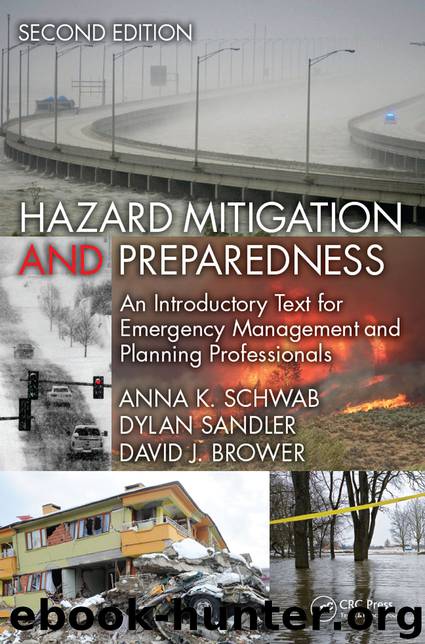Hazard Mitigation and Preparedness by Schwab Anna K. Brower David J. Sandler Dylan

Author:Schwab, Anna K., Brower, David J., Sandler, Dylan
Language: eng
Format: epub
Publisher: Taylor and Francis
8.5 Local Government Powers to Manage Growth and Development in Hazard Areas: “RATES”
As we discussed in previous sections, public controls on private property are not a recent innovation. Land use laws existed in various forms in England long before the United States existed, and even extend back into the ancient Roman past. The earliest code of Roman law, the Twelve Tables (451–540 BC), required setbacks for structures from parcel boundaries and regulated the distances between trees and lot lines. From the time the concept of private ownership arose in our legal tradition, property has literally been subject to the “law of the land.”
What the law of the land means for the average landowner has been variously interpreted over the years, vacillating between times of expansion and retrenchment depending on the societal and economic conditions of the day. Early on, judge-made law, such as the law of nuisance, was sufficient to handle land use conflicts. In its simplest form, under the nuisance law, a property owner who uses his or her property in such a way that it causes annoyance, inconvenience or danger to the public or to another property owner can be ordered by a court of law to put an end to the “nuisance.” But as our society became more complex and populous, and as increasing demands were placed on limited natural resources, there was a need for more extensive public land use controls. Today, these land use controls are adopted by state and local governments under the police power to manage the characteristics of growth.
RATES: In this section, we will examine some of the fundamental powers that local governments possess under their basic police power authority. These powers are popularly referred to by the acronym RATES: Regulation, Acquisition, Taxation, Education, and Spending. We will also discuss planning as a very powerful tool that can help create a cohesive framework for all other local powers in the context of mitigating the impacts of natural hazards and adapting to climate change (see Table 8.1).
TABLE 8.1 Local Government Powers to Control Land Use and Development
Regulation
Local governments have the power to control land use through regulations such as zoning, subdivision ordinances, floodplain regulations, etc. Regulation also includes building codes and standards to make structures more hazards resilient
Download
This site does not store any files on its server. We only index and link to content provided by other sites. Please contact the content providers to delete copyright contents if any and email us, we'll remove relevant links or contents immediately.
SAS Survival Handbook by John 'Lofty' Wiseman(2579)
Food and Water in an Emergency by Food & Water In An Emergency(2266)
The Splendid and the Vile by Erik Larson(2225)
Hidden Valley Road by Robert Kolker(2111)
Food Storage for Self-Sufficiency and Survival by Angela Paskett(1890)
Extreme Food - What to Eat When Your Life Depends on It... by Bear Grylls(1708)
The Smartest Kids in the World by Amanda Ripley(1681)
100 Skills You'll Need for the End of the World (as We Know It) by Ana Maria Spagna(1613)
Hawke's Green Beret Survival Manual by Mykel Hawke(1601)
The Survival Savvy Family by Julie Sczerbinski(1561)
How to Invent Everything by Ryan North(1559)
Prepper's Survival Medicine Handbook: A Lifesaving Collection of Emergency Procedures from U.S. Army Field Manuals by Scott Finazzo(1533)
The Knowledge: How to Rebuild our World from Scratch by Lewis Dartnell(1533)
Spy Secrets That Can Save Your Life: A Former CIA Officer Reveals Safety and Survival Techniques to Keep You and Your Family Protected by Jason Hanson(1476)
Prepper's Armed Defense by Jim Cobb(1453)
Lost and Stranded by Timothy Sprinkle(1448)
Mother Earth News Almanac by Mother Earth News(1448)
The Complete U.S. Army Survival Guide to Foraging Skills, Tactics, and Techniques by Jay McCullough(1426)
Brain Rules: 12 Principles for Surviving and Thriving at Work, Home, and School by John Medina(1422)
